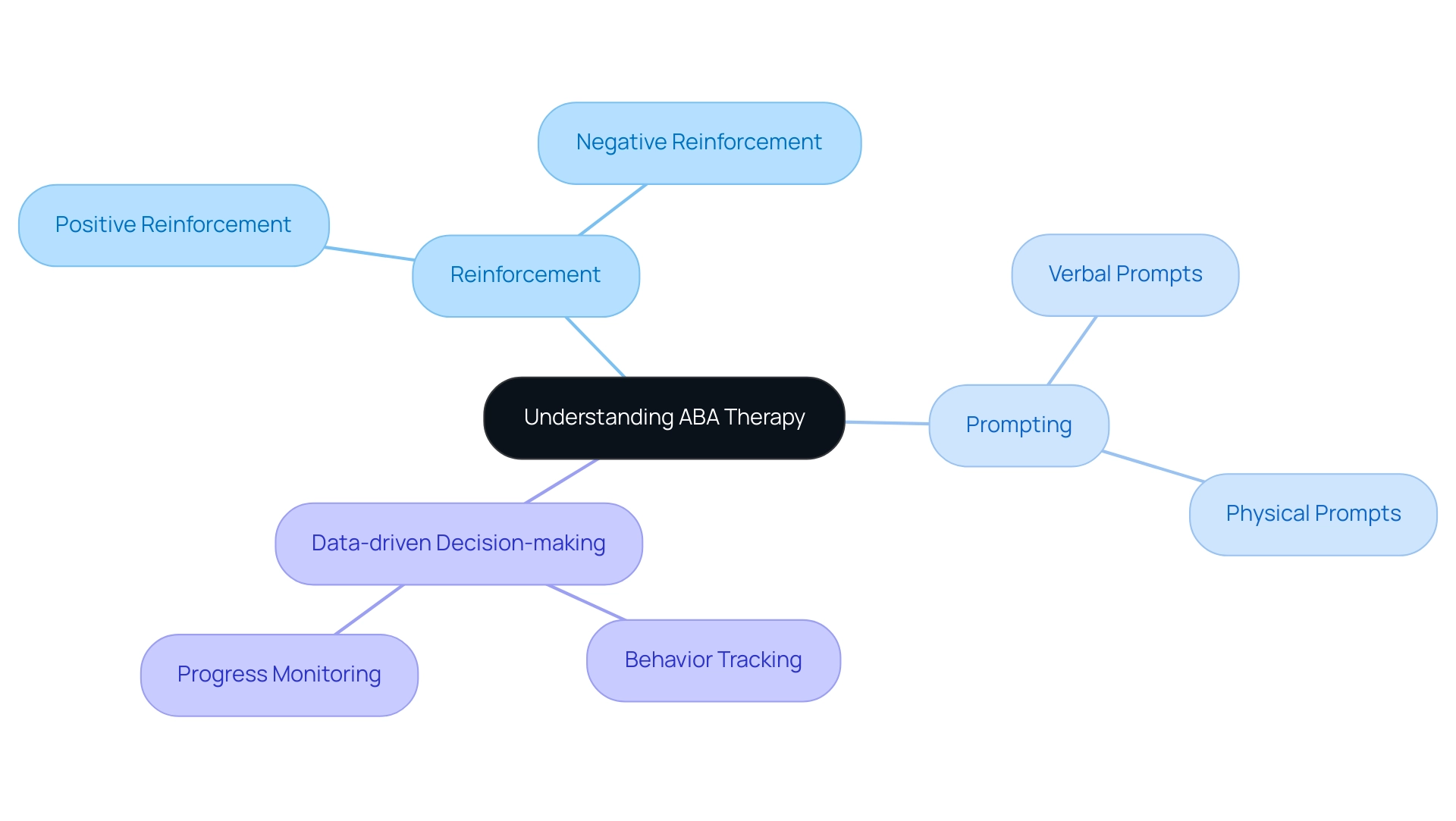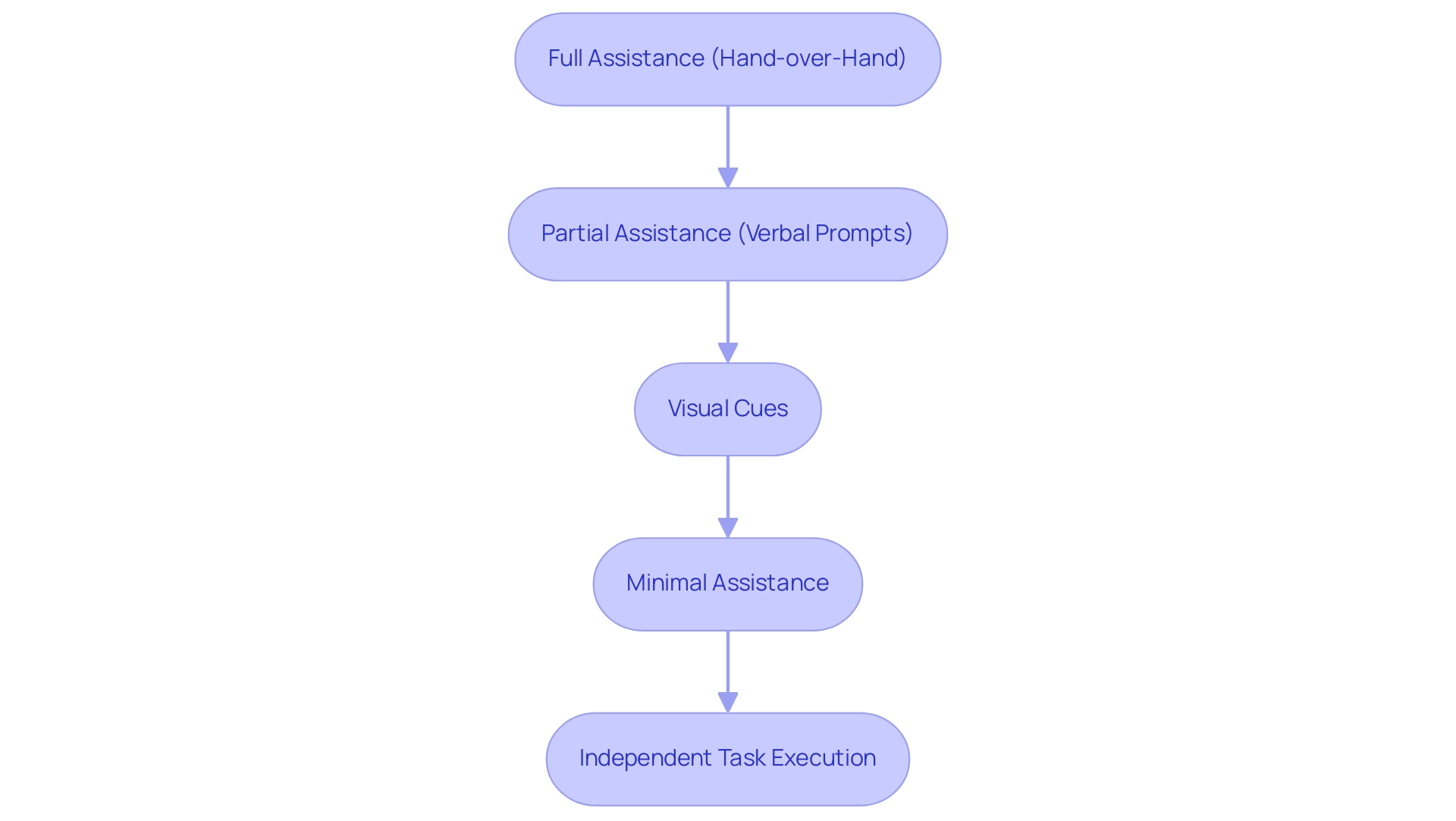Introduction
Navigating the complexities of behavioral challenges can be a daunting journey for parents, especially when seeking effective support for their children. Applied Behavior Analysis (ABA) therapy stands out as a proven approach, offering a framework to understand and modify behaviors in children with autism and ADHD. This article delves into the foundational principles of ABA therapy, practical techniques such as fading strategies, and the importance of individualized interventions.
By exploring the diverse methods within ABA, parents can empower themselves with the knowledge to tailor effective strategies that nurture their child's growth and development. Additionally, understanding how to measure progress can enhance collaboration with professionals, ensuring that every step taken is a step toward success. Embrace the potential of ABA therapy and discover how it can transform challenges into opportunities for positive change.
Understanding ABA Therapy: Foundations and Importance
Applied Behavior Analysis (ABA) intervention is a scientifically validated approach that focuses on understanding and modifying behavior through systematic techniques and strategies. It is particularly beneficial for individuals with autism and ADHD, as it helps develop essential skills, reduce challenging behaviors, and promote positive social interactions.
The foundations of ABA practice are built on principles of behaviorism, emphasizing the importance of:
- Reinforcement
- Prompting
- Data-driven decision-making
By grasping these fundamental ideas, parents can better value how ABA treatment can be customized to address their offspring's unique requirements, promoting an atmosphere favorable to growth and development.

Practical Fading Strategies in ABA Therapy
Fading is a technique utilized in ABA therapy to gradually lessen prompts and support as an individual becomes more skilled in a task. For instance, when instructing a young one to tie their shoes, a therapist may initially use hand-over-hand assistance. As the young one gains confidence, the therapist can reduce their assistance by providing verbal prompts or visual cues, eventually allowing the individual to perform the task independently. This gradual reduction in support not only helps the young one master the ability but also fosters independence and self-worth.
Parents can implement fading strategies by observing their child's progress and adjusting support levels accordingly, ensuring a smooth transition to independent task execution.

Exploring Diverse ABA Techniques for Effective Interventions
ABA therapy includes a range of techniques, each aimed at tackling specific behavioral challenges and fostering development. Some common methods include:
- Discrete Trial Teaching (DTT): This structured method divides abilities into small, manageable tasks, allowing for focused instruction and reinforcement.
- Functional Communication Training (FCT): FCT instructs young individuals to express their needs effectively, reducing frustration and challenging behaviors.
- Natural Environment Teaching (NET): This technique involves teaching skills in everyday settings, promoting generalization and real-world application.
By understanding and utilizing these diverse techniques, parents can create a tailored intervention plan that aligns with their offspring's learning style and needs.
Tailoring ABA Interventions: Individualized Approaches for Success
Successfully tailoring ABA interventions to the unique needs of each individual is vital for fostering positive developmental outcomes. This process begins with a thorough assessment of the individual's strengths, challenges, and interests, allowing for the creation of a personalized intervention plan. Studies indicate that youngsters undergoing customized ABA therapy achieve a success rate of around 80% in enhancing communication abilities and social interactions.
For example, if a young learner thrives with visual aids, integrating visual schedules or charts can significantly enhance their learning experience. A notable case study involved a five-year-old who, through individualized interventions focusing on his interest in trains, improved his social skills and communication abilities within six months.
Furthermore, incorporating the favorite toys or activities of the young one into therapy not only boosts motivation but also increases participation, making the sessions more enjoyable. Recent news highlights the development of autism-friendly home automation solutions that further support individualized ABA interventions by enhancing communication and comfort for individuals with autism.
Collaboration with ABA professionals is essential in developing these individualized strategies, as it ensures that the interventions are as effective as possible. As Ralph Moller wisely states,
It is important to note that early diagnosis and intervention do not aim to 'cure' autism but rather provide support and interventions to help manage symptoms, enhance skills, and promote overall well-being.
By prioritizing tailored approaches, parents can empower their offspring to reach their full potential in a supportive and understanding environment.
Measuring Success in ABA Therapy: Tracking Progress and Outcomes
Monitoring progress in ABA therapy is essential for evaluating the effectiveness of interventions and enabling parents to actively engage in their offspring's development. Research shows that systematic data collection methods can improve outcomes by 20-30%, illuminating areas of success and those needing adjustment. Parents can:
- Maintain a behavior log
- Track the frequency of target behaviors
- Employ visual charts to represent progress over time
For example, using a daily behavior chart can help parents visualize trends in their offspring's behavior, making it easier to identify patterns and triggers. Regular collaboration with ABA professionals ensures that data is reviewed and utilized for informed decision-making.
For instance, in a case study involving a young individual with autism, consistent data tracking revealed that changes in the environment significantly impacted the person's engagement levels, allowing the team to modify their approach effectively. As Dr. Tyra Sellers emphasizes, active participation in data tracking fosters a collaborative environment where families feel empowered and informed about their offspring's journey.
By engaging in this process, parents not only gain crucial insights into their offspring's development but also create opportunities to celebrate their achievements, reinforcing the positive impact of ABA therapy. With over 1,500 customizable protocols available, parents are equipped with the tools necessary to support their child's growth and healing.
![]()
Conclusion
Understanding and implementing Applied Behavior Analysis (ABA) therapy can significantly transform the journey of parenting a child with autism or ADHD. By grasping the foundational principles and employing practical techniques such as fading strategies, parents can create a nurturing environment that fosters independence and self-esteem. The diverse methods within ABA, from Discrete Trial Teaching to Functional Communication Training, provide parents with the flexibility to tailor interventions that align with their child's unique learning styles and needs.
Individualized approaches are essential for success in ABA therapy. By assessing each child's strengths and interests, parents can collaborate with professionals to develop personalized plans that enhance communication and social skills. The positive outcomes from tailored interventions underscore the importance of early diagnosis and proactive support.
Moreover, measuring progress through systematic data collection empowers parents to stay engaged in their child's development. This collaborative approach not only highlights successes but also identifies areas for adjustment, ensuring that each step taken is purposeful and impactful. Embracing ABA therapy means embracing the potential for growth, turning challenges into opportunities for positive change.
With the right resources and support, parents can confidently navigate this path, championing their child's journey toward a brighter future.
Frequently Asked Questions
What is Applied Behavior Analysis (ABA) intervention?
ABA intervention is a scientifically validated approach that focuses on understanding and modifying behavior through systematic techniques and strategies, particularly beneficial for individuals with autism and ADHD.
What are the foundational principles of ABA practice?
The foundations of ABA practice are built on principles of behaviorism, emphasizing reinforcement, prompting, and data-driven decision-making.
How does the fading technique work in ABA therapy?
Fading is a technique that gradually lessens prompts and support as an individual becomes more skilled in a task, promoting independence and self-worth.
What are some common techniques used in ABA therapy?
Common methods include Discrete Trial Teaching (DTT), Functional Communication Training (FCT), and Natural Environment Teaching (NET), each aimed at addressing specific behavioral challenges.
Why is tailoring ABA interventions important?
Tailoring ABA interventions to the unique needs of each individual is vital for fostering positive developmental outcomes, as personalized plans enhance communication abilities and social interactions.
How can parents monitor progress in ABA therapy?
Parents can monitor progress by maintaining a behavior log, tracking the frequency of target behaviors, and using visual charts to represent progress over time.
What role do ABA professionals play in individualized strategies?
Collaboration with ABA professionals is essential in developing individualized strategies, ensuring that interventions are effective and tailored to the child's needs.
What is the significance of early diagnosis and intervention in ABA therapy?
Early diagnosis and intervention aim to provide support and interventions to help manage symptoms, enhance skills, and promote overall well-being rather than 'cure' autism.




